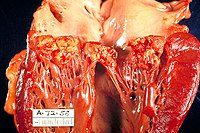
Photo from wikipedia
Abstract Background: Pulmonary vascular damage may be associated with oxidative stress in congenital heart diseases. We investigated whether small ventricular septal defects have an effect on the pulmonary bed. Methods:… Click to show full abstract
Abstract Background: Pulmonary vascular damage may be associated with oxidative stress in congenital heart diseases. We investigated whether small ventricular septal defects have an effect on the pulmonary bed. Methods: This prospective cohort study included 100 patients with small ventricular septal defects and 75 healthy controls. Ischemia-modified albumin, high-sensitivity C-reactive protein, and various cardiovascular parameters were assessed in both groups. Results: The mean ischemia-modified albumin level was significantly higher in patients with small ventricular septal defects (0.62 ± 0.17 absorbance units) than in the control group (0.51 ± 0.09 absorbance units; p < 0.001). The mean high-sensitivity C-reactive protein level was significantly higher in the ventricular septal defects group (3.72 ± 1.57) than in the control group (2.45 ± 0.89; p < 0.001). The ischemia-modified albumin levels in patients with left ventricular internal diameter end diastole and end sistole and main pulmonary artery z-scores ≥ 2 were significantly higher than patients whose z-scores were <2. The ischemia-modified albumin and high-sensitivity C-reactive protein levels were positively correlated in the small ventricular septal defects group (rho = 0.742, p < 0.001). Receiver operating characteristic analyses showed that at the optimal cut-off value of ischemia-modified albumin for the prediction of pulmonary involvement was 0.55 absorbance units with a sensitivity of 60%, specificity of 62% (area under the curve = 0.690, p < 0.001). Conclusions: We demonstrated the presence of oxidative stress and higher ischemia-modified albumin levels in small ventricular septal defects, suggesting that ischemia-modified albumin might be a useful biomarker for evaluating the effects of small ventricular septal defects on the pulmonary bed.
Journal Title: Cardiology in the Young
Year Published: 2021
Link to full text (if available)
Share on Social Media: Sign Up to like & get
recommendations!